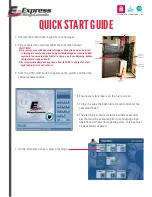
System Operation and Maintenance
29
6.4. Electrical Connection Inspection
6.4.1.
Electrical Maintenance
Perform visual inspection and treatment to electrical connections according to the following items:
1. Electrical insulation test of the whole system: Find defective contacts and correct the defects. During the test, disconnect
the fuse or MCB of the control section to avoid damage to the control panel due to high voltage.
2. Statically check whether each contactor is flexible and jammed.
3. Use a brush or dry compressed air to remove dust from electrical and control components.
4. Check whether the contacts of the contactor are drawn for arcing and have burn marks. If it is serious, replace the
corresponding contactor.
5. Fasten the electrical connection terminals.
6. Check whether the fan’s quick-to-plug terminals are in good contact. If any looseness is found, replace the terminals.
7. If the power supply cable is damaged, in order to avoid danger, it must be replaced by a professional from the
manufacturer’s maintenance department.
6.4.2.
Control Maintenance
Perform visual inspection, simple function inspection and processing of the control part according to the following items:
1. Check the appearance of the transformer and check the output voltage.
2. Check the control interface board, control board, temperature and humidity sensor board, fan failure detection board,
electronic expansion valve control board and other surfaces for any sign of aging.
3. Clean the dust and dirt on the electrical control components and control panel, and clean it with help of a brush and
electronic dust remover.
4. Check and firmly connect the output and input plugs of all control interface board such as temperature and humidity
sensor board, fan failure detection board, and electronic expansion valve control board.
5. Check the connection between the user cabling/wiring control terminals (37#, 38#, CANH/CANL, etc.), and the control
interface board.
6. Check whether the contact and connection of the fan power supply cables, signal cables, and speed feedback signal
interfaces are connected firmly.
7. Check the connection of the control interface board to the its corresponding terminals of the temperature and pressure
sensors. If the connection is loose, or has poor contact, failure, etc., replace it immediately.
8. Replace the control fuse (or MCB), control board and other electrical components that have been detected with
problems.
9. Use temperature and humidity measuring instruments with higher measurement accuracy to measure and calibrate the
readings of temperature and humidity sensors.
10. Adjust the setpoints and check the action of each functional component according to the control logic.













































